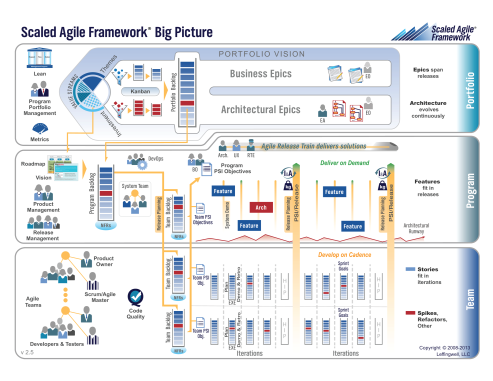As a long time product management professional and agile coach, I welcome any opportunity that delivers business impact and allows organizations to achieve remarkable results. For too long, “agile” was deemed only relevant for development teams and “lean thinking” was reserved for shop floors in modern manufacturing facilities (think Toyota Production System (TPS)). Interestingly, agile is increasingly permeating new departments (e.g., marketing) and management strategies, like portfolio analysis and budgeting. With that in mind, I’d like to introduce the Scaled Agile Framework (or SAFe), a framework that aims to synchronize vision, planning, interdependencies, across an organization and delivery teams. The target outcome is business agility.
What is the Scaled Agile Framework?
First, a little context. SAFe was largely developed because of the lack of guidance beyond team level SCRUM. Anyone who has been around agile and multiple teams, have at one time or another discussed scaling agile (or scaling SCRUM). For the most part, these discussions have been mainly relegated to thoughts around “scrum-of-scrums”. And for many, especially smaller shops with 2-3 teams, this is probably good enough (reads better than nothing). However, for larger organizations, especially those with larger and more complex systems to develop and support, SCRUM does not provide very much guidance around scaling. With agile adoption at all-time highs, increasingly the market was searching for new ideas and tools at the program and portfolio level (think up stream). Until SAFe, and despite being on the same team (presumably) business and IT (or development) have been largely disconnected, plagued with mis-understandings and fraught with routine finger pointing.
The good news is, noting that’s it’s been over 13 years since the agile manifesto,the community has responded and has now put forward several new approaches to scaling agile, most notably, the Scaled Agile Framework or SAFe (I understand the “e” was added simply to help pronounce the acronym). To that end, SAFe is a well-documented approach for implementing agile at enterprise scale. Increasing recognized by its “Big Picture” graphic, SAFe provides a model for enterprise agility. Before SCRUM purists get upset, let’s remember that most schools of thought around best practices, methodologies or processes etc., evolve over time. Besides, SAFe builds on SCRUM--- it doesn’t displace it.
Why you should care about agile
Getting back to “why you should care?” Agile is almost always adopted from the bottom up. That is, it starts with one development team. Usually, a well-chosen pilot team whereby the “deck is stacked” to minimize the likelihood of failure and almost guarantee success. After all, management is seeking a quick win to help establish a beachhead going forward (and keep the naysayers at rest). By all measures, this is one of several successful approaches. Regardless of how you get there, eventually agile is adopted at the TEAM level across the enterprise. Unfortunately, this is also where organizations fall short of achieving the ultimate goal --- not agile adoption (although that is a good start) but coveted “ business agility ".
Not surprisingly, this epicenter is also where business meets IT/development. Unless a collaborative flow of value (think “concept-to-cash”) is achieved, organizations (executives included) often dupe themselves into believing they are “agile” because they have adopted SCRUM or agile practices at the team level. To be clear, agile teams ≠ business agility. Companies only achieve business agility when their decision making ability and response time are equal or faster than the rate at which markets or business environments change. This cannot be achieved with SCRUM alone. Fortunately, this is where SAFe, building on the foundation or SCRUM, XP, Kanban etc. helps lubricate the flow of value across the organization (both up and down).
To conclude, it’s important to first recognize that agile is no longer reserved for early adopters. To the contrary --- it’s gone mainstream and if you aren’t already practicing it, you and your organization are already behind. Businesses are increasingly targeting enterprise agility so that they can identify the need for change, respond optimally to new demands and set the pace (i.e., market leadership) in their industry. Having said that, scaling agile, whereby extraordinary business results are achieved not solely at the team level, but realized by an enterprise wide collaborative effort targeting common business objectives (e.g., reduced time to market), is the new “must have” to maintain competitiveness. In essence, if you aren’t doing it --- you can bet the “other guys” are.
In the coming weeks, I will not only elaborate on the topic, but also provide practical guidance and insight how Microsoft’s Team Foundation (TFS) 2013 can be configured and used to support SAFe across your enterprise.










